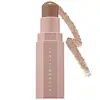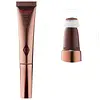What's inside
What's inside
 Key Ingredients
Key Ingredients

 Benefits
Benefits

 Concerns
Concerns

 Ingredients Side-by-side
Ingredients Side-by-side

Tricaprylin
MaskingC12-15 Alkyl Ethylhexanoate
EmollientPolyethylene
AbrasivePolymethyl Methacrylate
Octyldodecanol
EmollientSucrose Acetate Isobutyrate
Mica
Cosmetic ColorantCera Microcristallina
Emulsion StabilisingOctyldodecyl Neopentanoate
EmollientSilica
AbrasivePolymethylsilsesquioxane
Caprylyl Glycol
EmollientCetyl PEG/PPG-10/1 Dimethicone
EmulsifyingVp/Eicosene Copolymer
Vp/Hexadecene Copolymer
Cocos Nucifera Oil
MaskingPentaerythrityl Tetra-Di-T-Butyl Hydroxyhydrocinnamate
AntioxidantTocopheryl Acetate
AntioxidantAscorbyl Palmitate
AntioxidantSodium Hyaluronate
HumectantTocopherol
AntioxidantCalcium Sodium Borosilicate
Synthetic Fluorphlogopite
Calcium Aluminum Borosilicate
Polyethylene Terephthalate
Acrylates Copolymer
Tin Oxide
AbrasiveTitanium Dioxide
Cosmetic ColorantIron Oxides
CI 15985
Cosmetic ColorantCI 19140
Cosmetic ColorantBHT
AntioxidantCI 77891
Cosmetic ColorantTricaprylin, C12-15 Alkyl Ethylhexanoate, Polyethylene, Polymethyl Methacrylate, Octyldodecanol, Sucrose Acetate Isobutyrate, Mica, Cera Microcristallina, Octyldodecyl Neopentanoate, Silica, Polymethylsilsesquioxane, Caprylyl Glycol, Cetyl PEG/PPG-10/1 Dimethicone, Vp/Eicosene Copolymer, Vp/Hexadecene Copolymer, Cocos Nucifera Oil, Pentaerythrityl Tetra-Di-T-Butyl Hydroxyhydrocinnamate, Tocopheryl Acetate, Ascorbyl Palmitate, Sodium Hyaluronate, Tocopherol, Calcium Sodium Borosilicate, Synthetic Fluorphlogopite, Calcium Aluminum Borosilicate, Polyethylene Terephthalate, Acrylates Copolymer, Tin Oxide, Titanium Dioxide, Iron Oxides, CI 15985, CI 19140, BHT, CI 77891
Water
Skin ConditioningCyclopentasiloxane
EmollientIsododecane
EmollientMica
Cosmetic ColorantCetyl PEG/PPG-10/1 Dimethicone
EmulsifyingPolyglyceryl-4 Diisostearate/Polyhydroxystearate/Sebacate
EmulsifyingTriethylhexanoin
MaskingPhenylisopropyl Dimethicone
Skin ConditioningGlycerin
HumectantSilica
AbrasiveHydrogenated Starch Hydrolysate
HumectantDisteardimonium Hectorite
StabilisingHydroxyacetophenone
AntioxidantSodium Chloride
MaskingAlcohol
Antimicrobial1,2-Hexanediol
Skin ConditioningCaprylyl Glycol
EmollientTrisodium Ethylenediamine Disuccinate
Lindera Strychnifolia Root Extract
Skin ConditioningPhenoxyethanol
PreservativeEthylhexylglycerin
Skin ConditioningTitanium Dioxide
Cosmetic ColorantIron Oxides
Water, Cyclopentasiloxane, Isododecane, Mica, Cetyl PEG/PPG-10/1 Dimethicone, Polyglyceryl-4 Diisostearate/Polyhydroxystearate/Sebacate, Triethylhexanoin, Phenylisopropyl Dimethicone, Glycerin, Silica, Hydrogenated Starch Hydrolysate, Disteardimonium Hectorite, Hydroxyacetophenone, Sodium Chloride, Alcohol, 1,2-Hexanediol, Caprylyl Glycol, Trisodium Ethylenediamine Disuccinate, Lindera Strychnifolia Root Extract, Phenoxyethanol, Ethylhexylglycerin, Titanium Dioxide, Iron Oxides
 Reviews
Reviews

Ingredients Explained
These ingredients are found in both products.
Ingredients higher up in an ingredient list are typically present in a larger amount.
Caprylyl Glycol is a humectant and emollient, meaning it attracts and preserves moisture.
It is a common ingredient in many products, especially those designed to hydrate skin. The primary benefits are retaining moisture, skin softening, and promoting a healthy skin barrier.
Though Caprylyl Glycol is an alcohol derived from fatty acids, it is not the kind that can dry out skin.
This ingredient is also used as a preservative to extend the life of products. It has slight antimicrobial properties.
Learn more about Caprylyl GlycolThis ingredient is a high molecular weight silicone. It has emulsifying and skin conditioning properties.
Mica is a naturally occurring mineral used to add shimmer and color in cosmetics. It can also help improve the texture of a product or give it an opaque, white/silver color.
Serecite is the name for very fine but ragged grains of mica.
This ingredient is often coated with metal oxides like titanium dioxide. Trace amounts of heavy metals may be found in mica, but these metals are not harmful in our personal products.
Mica has been used since prehistoric times throughout the world. Ancient Egyptian, Indian, Greek, Roman, Aztec, and Chinese civilizations have used mica.
Learn more about MicaSilica, also known as silicon dioxide, is a naturally occurring mineral. It is used as a fine, spherical, and porous powder in cosmetics.
Though it has exfoliant properties, the function of silica varies depending on the product.
The unique structure of silica enhances the spreadability and adds smoothness, making it a great texture enhancer.
It is also used as an active carrier, emulsifier, and mattifier due to its ability to absorb excess oil.
In some products, tiny microneedles called spicules are made from silica or hydrolyzed sponge. When you rub them in, they lightly polish away dead skin layers and enhance the penetration of active ingredients.
Learn more about SilicaTitanium dioxide is a mineral UV filter widely used in sunscreens and cosmetics.
It is one of only two UV filters officially classified as “mineral” by regulatory agencies, the other being zinc oxide.
Titanium dioxide provides broad-spectrum protection mostly in the UVB and UVAII range, with some protection in the UVAI range.
While its UVA protection isn’t as strong as zinc oxide’s, the difference is minor.
A common myth is that mineral UV filters reflect UV light. However, modern research shows titanium dioxide absorbs UV radiation like chemical filters (~95% absorption & 5% reflection).
Thanks to its non-irritating nature, titanium dioxide is suitable for sensitive, acne-prone, or redness-prone skin. It is unlikely to cause "eye sting" like other sunscreen ingredients.
A major drawback of this ingredient is its white cast and thick texture. This is why mineral sunscreens often leave a white cast and are less cosmetically elegant than chemical/hybrid sunscreens.
To improve white cast and spreadability, micronized or nano-sized titanium dioxide is often used.
There are ongoing concerns surrounding nano-titanium oxide's impact on marine ecosystems.
There is no conclusive evidence that any form of titanium oxide (or any other sunscreen ingredients) will cause harm to marine ecosystems or coral reefs. The science is still developing but many consumers are keeping a close eye on this issue.
Please note, many destinations have reef-safety sunscreen rules. For instance, the U.S. Virgin Islands advises all visitors to use non-nano mineral sunscreens.
Nano mineral sunscreens once raised safety concerns about absorption into skin.
Extensive research has shown that they do not penetrate healthy or damaged skin; they remain safely on the surface and the top layer of dead skin (stratum corneum).
You'll likely find titanium dioxide bundled with alumina, silica, or dimethicone. These ingredients help make titanium dioxide highly photostable; this prevents it from interacting with other formula components under UV light.
Learn more about Titanium DioxideThis ingredient is a combination of red, black, and yellow iron oxide pigments. This combination of colors is usually found in foundation, because it results in a "skin" color.